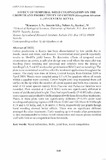Effect of temporal weed colonization on the growth and productivity of cotton (Gossypium hirsutum l.) in central Kenya

View/
Date
2011-09Author
Kasina, M
Nelson, A.
Jenesio, I.K.
Kimunye, J. N.
Language
enMetadata
Show full item recordAbstract
Cotton production in Kenya has been characterized by low yields due to
weeds, insect and mites, and diseases. Uncontrolled weed growth reportedly
results to 50-60% yield losses. To determine effects of temporal weed
colonization on cotton, a split plot design was used where the main plot was
weeding (hand weeding and spraying) and subplots were the timing of
weeding (3, 6, 9 and 12 weeks after germination (WAG) and no weeding). The
plots were maintained weed free after the treatment application throughout the
season. The study was done at Mwea, Central Kenya, from October 2009 to
April 2010. Weeds were sampled using 0.5 x 0.5m quadrats where all weeds
within a quadrat were counted. Cotton height (ern) was measured from soil
surface to the tip while the number of cotton squares and bolls was counted. A
total of 43 weed species mainly from Poaceae and Fabaceae families were
recorded. Plots weeded at 3 and 6 WAG were not significantly different in
terms of yields and plant height. They had significantly (P<0.05) taller plants,
more squares and productive bolls compared with those from other treatments.
Plants in these plots were not significantly different (P<0.05) under hand
weeding and spraying regimes (108.14cm±0.687 and 104.39cm±0.950 height
8.19 and 6.43 bolls, and, 8.26 and 6.13 bolls, respectively per plant) though
hand weeding showed better effects. There was no significant different
amongst the other treatments. Early weeding up to 6 weeks after germination
is thus recommended to reduce weed colonization and ensure plants establish
well with little or no competition from the weeds.
Citation
Optimimization of Agricultural Value Chains for sustainable DevelopmentSponsorhip
National Council of Science and Technology, The Kenya Seed CompanyPublisher
Faculty of Agriculture, University of Nairobi
